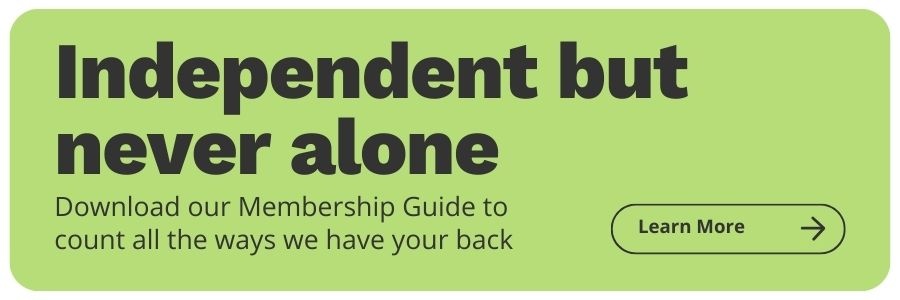15 Free Branding Resources for Financial Advisors
Share this
Your visual branding is the first impression you make on prospective clients. It is key to establishing your brand identity, setting you apart from competitors, and creating a believable, trustworthy image of your business. In other words, your visual branding is key to helping you connect with your clients, both prospective and current.
Many business owners convince themselves that investing in visual appearance is unnecessary, or that it can wait. But your branding can take your business to another level simply by speaking to your clients’ interests, values, and pain points through design, imagery, and tone. Even something like thead right choice of colors can influence a prospective client’s judgment.
While you may not have the budget to support a visual brand created by an expert graphic designer or brand strategist, there are so many online tools that can help you shortcut the process—and the cost—of building killer visual content without sacrificing quality.
Choosing the Right Photos
This is a big one. Whether you use them on your website, as blog images, or on physical marketing materials, photos can be an effective, powerful way to evoke emotions in your marketing. Showing a couple laughing with their small child instills an intimate feeling of family, while using a photo of an adrenaline pumping biker racing down a mountain can immediately capture the attention of an adventure chasing crowd.
When choosing photos, think about the purpose of the photo (too often people rely on photos simply to fill space) and what emotions you are trying to convey. Do you want your audience to feel inspired, empowered, or happy? Remember, your goal through your visual branding is to connect with people through compelling design. Choosing a memorable image that will evoke an emotional response in your audience is one of the best ways to make that connection.
There are some great free stock photo sites out there. Before you dive in, there are some things to consider to avoid using the same images as everyone else.
- Avoid “stocky” images. These are the cliche photos of a “business handshake” over a desk with papers or the classic “woman laughing eating a salad.”
Determine the tone you're trying to convey and the emotions you're trying to evoke and think about how you can reframe your search. Use a thesaurus, or set a timer for 1-2 minutes and brainstorm a word list. For example, a word list for a blog about quitting your job to start your own business might look like this:
-Job
-Quit
-Start
-Jump
-Leap
-Freedom
-Alone
-Budget
After a few rounds of narrowing it down, you will be left with some fresh ideas around which to reframe your photo search.
- Consider your colors. For a professional look, make sure all of the images you use have the same color tone. Take it up a notch by using a color tone that mirrors or complements your brand colors (more on that below).
- Symbols are powerful. They provide a visual shorthand that makes them valuable communication devices. They have the power to transform abstract concepts, ideas, and beliefs into things we can understand in a glance. Heart= love, exclamation mark= important, lightbulb = idea. Symbols are a simple way to pack meaning into your brand.
- Images tell a story. Searching your symbol/icon and an emotion (one from your list is a great place to start), can produce results of images that help tell a story and build the mood of your marketing. For example, if you search “tree + adventure,” you might find a photo of someone jumping off a rope swing. This is a great, and likely less overused, choice for an article about taking a leap.
Here are some of my favorite free online resources for stock imagery:
Choosing the Right Colors
Color can be tricky. Color is a foundational building block of a brand, but with infinite shades on the color spectrum, feeling confident in your color choices can seem next to impossible.
We all know the typical color associations, like green=calm and yellow=joy, but colors can be used in many different ways beyond their stereotypes. For example, green might be used for an environmentally-focused company, or it might be used more literally, like in the case of the popular banking app Mint.com.
Just like symbols, color is subjective so it is important to focus on the personality of your brand when choosing colors that connect. Psychologist and Stanford professor Jennifer Aaker researches brand personalities; in her paper “Dimensions of Brand Personality,” she points out the five dimensions that play a role in a brand’s personality:
- Sincerity: Down-to-earth, Honest, Wholesome, and Cheerful
- Excitement: Daring, Spirited, Imaginative, Up-to-date
- Competence: Reliable, Intelligent, Successful
- Sophistication: Upper-class, Charming
- Ruggedness: Outdoorsy, Tough
Just like human personalities, brand personalities can be a mixed bag. After all, you want your brand to be multidimensional, not monotone. But don’t overdo it, and remember that consistency is key. Keep your brand personality and audience in mind when making color decisions, like if that yellow accent color you want to use is a bit too exciting for your upscale country club’s website.
Here are some of my favorite free online color resources:
- Coolors, a color scheme generator
- Adobe Color CC, a color generator
- Color Hunt, a curated collection of color schemes
Choosing the Right Graphics
One of the easiest ways to make sure your marketing material stays visually consistent is by building an asset library. Every designer has an asset library of ready-to-go and most frequently used graphics for those tight deadlines and to ensure consistency across visual content.
An asset library cuts down the time you have to spend endlessly scrolling through stock photos or trying to remember where you found that one icon you used on your website ages ago. It also allows you to send pre-approved visual content to anyone you might be outsourcing your marketing to.
To get started, create a neatly organized folder that houses your brand’s logo(s), fonts, key photos (or a collection of pre-approved images to use at a later date), and any supporting graphics like icons and illustrations.
In this folder should be a copy of your brand’s guidelines. These guidelines should include examples of approved sizes and color variations for your logo, the RGB or CMYK codes for your brand color scheme, and font specifications. More specific information you might want to include if you plan on outsourcing any of your visual content is your business’s mission statement, iconography (what icons are used for what/where), and example images showing your brand’s visual tone.
You can find a wide range of pre-made graphics, templates, backgrounds, textures, and illustrations online. You might have to spend a bit of money here, but prices are typically very reasonable. Whatever look you are going for, chances are someone has created a graphic—whether a template, a background, or an illustration—that can help you achieve your vision without the price tag of a custom piece.
The key again is to keep your brand personality at the front of your mind while searching these resources. Having a clear idea of what hits the mark (and what most definitely doesn’t) helps move the decision-making process along faster.
Here are some of my favorite online resources for graphics:
- Creative Market, social media/website templates, illustrations, fonts, backgrounds. Weekly freebies
- Design Cuts, similar to Creative Market, with “weekly freebies”
- Iconfinder, thousands of web-ready icons in a wide range of styles
- Noun Project, similar to Icon Finder, but in a flat/monochromatic style
Using Builders to Create Visuals
Now that you have established your brand’s personality, curated a color palette, and selected images that fit your tone, you are ready to create.
Builder tools allow you to create beautiful, professional designs without any graphic design expertise. Whether you’re looking to design a new brochure or maybe some updated business cards, online builder resources can get the job done without headache or hassle.
In today’s digital age, there are a few really great options for online graphic builders. Most of these tools have large libraries of layouts and pre-sized templates so you can worry less about Facebook’s ever-changing photo guidelines and more about making sure your visual content will connect with your audience.
Here are some of my favorite online builders:
- Canva, create beautiful designs from blog images to flyers to presentations (you can even upload custom fonts with the paid, premium version)
- Adobe Express, similar to Canva without custom fonts; get access to Adobe Stock photos
- Piktochart, create professional infographics, presentations, and reports
*Bonus* Creating Compelling Video
If your marketing strategy involves video, you can produce quality video content with simple tricks and tools you already have on hand (like using your headphone microphone instead of the mic in your computer).
One of the best ways to give your videos that professional sparkle is to create a consistent, branded intro and outro (which is videospeak for opening and ending). You only have seven seconds to make an impression and create a bond with your audience, so intros are especially important in video. Renderforest.com is a great resource for creating compelling, consistent intros and outros. One tool in particular helps you create logo animation by simply uploading your logo. Their fancy algorithm does the heavy lifting, leaving you with an animated logo for your video intro that will truly trick your audience into thinking a professional built it.
Remember to have fun with these tools. They are meant to help you, but can easily become overwhelming. Decision fatigue seems almost imminent with the sheer number of choices. If you feel yourself getting stressed out by all of the different variations of a light blue for your accent color, take a deep breath and envision your brand’s personality, make a decision (hint: go with your gut), and stick with it. People will get confused if you constantly switch up your tone or play with your color scheme. The purpose of your visual brand is to create something that makes the right first impression and reaches the right audience, and then, with time and consistency, becomes the physical symbol of the trust you have earned of your audience
 About the Author
About the Author
As XYPN's Design Specialist (aka "Arts & Crafts Ninja"), Ivy infuses creativity and consistency into the XYPN brand. She has a hand in—and an eye on—all of XYPN's visual content, from website to swag. Her graphic and web design skills help bring XYPN's brand to life.
Share this
- Running Your RIA Efficiently: Outsourcing Bookkeeping with XYPN Books
- Road to Launch with XYPN Member Alan Skillern, CFP®, MBA
- Coaching for Better Time Management: Prioritizing Organic Growth in Your Daily Routine
- Boost Your Financial Advisory Practice: SEO Strategies and CRM Optimization for Sales Success
- Advisor Blog (693)
- Financial Advisors (221)
- Growing an RIA (99)
- Digital Marketing (87)
- Marketing (84)
- Community (81)
- Start an RIA (76)
- Business Development (72)
- Coaching (72)
- Running an RIA (70)
- Compliance (69)
- Client Acquisition (65)
- Technology (64)
- XYPN LIVE (59)
- Entrepreneurship (57)
- Sales (49)
- Practice Management (44)
- Client Engagement (41)
- Bookkeeping (38)
- XYPN Books (38)
- Investment Management (37)
- Fee-only advisor (36)
- Lifestyle, Family, & Personal Finance (31)
- Employee Engagement (30)
- Client Services (25)
- Financial Education & Resources (25)
- Journey Makers (21)
- Market Trends (21)
- Process (14)
- Niche (11)
- SEO (9)
- Scaling an RIA (9)
- Career Change (8)
- Transitioning Your Business (7)
- Partnership (6)
- Transitioning To Fee-Only (4)
- Social Media (3)
- Transitioning Clients (3)
- Emerald (2)
- Persona (2)
- RIA (2)
- Onboarding (1)
- Sapphire (1)
Subscribe by email
You May Also Like
These Related Stories

How to Create a Brand Book for Your Firm
Nov 26, 2018
5 min read

A Financial Advisor's Guide to Creating Visual Content
April 22, 2015
5 min read





